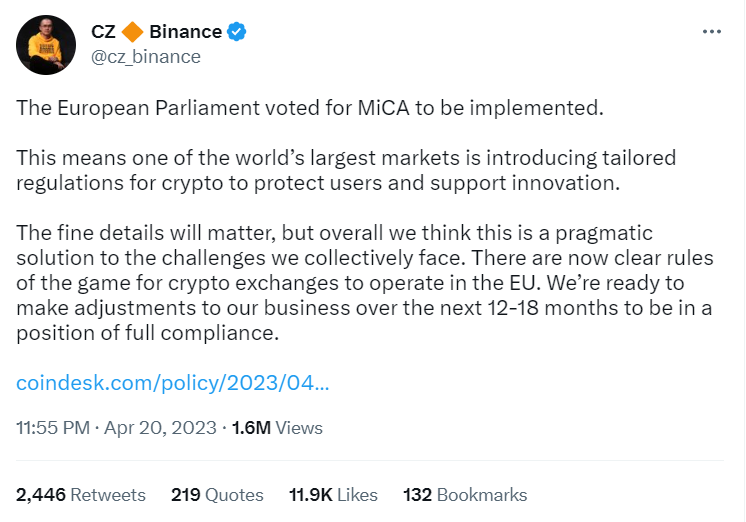
MiCA crypto regulation is coming to the European Union. Voted in by member states of the European Parliament, the measures will hopefully bring some much-needed clarity to how the crypto market is controlled.
After devastating failures like the LUNA and FTX collapses in the blockchain industry throughout 2022, MiCA aims to protect market participants. The new regulatory framework aims to improve consumer protection and hold crypto asset issuers and service providers more accountable.
Amidst rumors of Coinbase searching for a new legal home, the EU Parliament’s new rules are expected to pioneer a wave of change across the globe.
Sponsored
What exactly is covered by the scope of MiCA? Will Europe’s crypto asset regulation change how we use DeFi and NFTs? When will the European Commission start enforcing the changes?
What is MiCA Regulation?
MiCA (Markets in Crypto Assets) is a financial services legislation that aims to consolidate how digital assets are regulated across multiple European jurisdictions. It gives lawmakers across Europe a consistent set of rules for governing cryptocurrency stored on a distributed ledger (DLT) or similar technology, like a blockchain or DAG (directed acyclic graph).

A new anti-money laundering ‘travel rule’ requires crypto companies to register all the details of crypto transactions, including profiles of the sender and receiver. Ironically, this is one of the innate fundamentals of blockchain technology.
Sponsored
Additionally, transactions worth over 1,000 EUR between exchanges and self-hosted wallets must be reported. Understandably, this strikes a nerve with many crypto users who value their privacy and anonymity.
Objectives of MiCA Regulation in Europe
With the main focus of ensuring financial stability and providing clarity across the world of digital finance, the key objectives of MiCA regulation can be broken down into four main avenues:
- Establish a regulatory framework for crypto-assets not already covered by financial services legislation.
- Support emerging cryptocurrency-based businesses by providing safe and clear guidelines.
- Protect digital currency investors and market integrity by mitigating the risks of the crypto market.
- Achieve financial stability and consistent regulations Europe-wide, with a crackdown on market manipulation.
To curb market manipulation, MiCA demands that crypto asset issuers and service providers disclose information related to insider trading or other forms of market abuse.
What Crypto Assets Are Covered by MiCA?
MiCA seeks to categorize digital currencies into different classifications. It recognizes three types of crypto assets:
- Asset-referenced tokens – As the name suggests, ARTs refer to crypto assets designed to maintain a stable value derived from several fiat currencies, commodities, or baskets of crypto assets. ARTs are not to be confused with stablecoins, which are pegged to the value of one fiat currency only. A good example of an ART is Digix (DGX), a token pegged to the value of gold.
- Electronic money tokens – These are assets designed to reflect the value of a single fiat currency that is considered legal tender. E-money tokens refer to stablecoins and central bank digital currencies.
- Miscellaneous – This third category refers to any crypto asset not considered an ART or EMT. Utility tokens that provide holders access to goods or services. Unlike a security token, these are not regarded as financial instruments under typical securities laws in other nations.
It’s worth mentioning that DeFi activities, non-fungible tokens, and any future European Central Bank Digital Currencies (CBDCs) are excluded from the new MiCA regulation.
Cryptocurrency Issuers
To protect crypto enthusiasts from the litany of scam projects plaguing the crypto space, the MiCA regulation standard aims to hold crypto projects to a higher standard. Issuers of crypto assets will need to meet certain obligations.
Crypto issuers will need to publish a whitepaper that sufficiently outlines the expectations of the business. Moreover, issuers also need to have the correct authorization from lawmakers before selling crypto tokens or creating liquidity.
Crypto Asset Service Providers
Service providers in the crypto asset industry cover a broad range of businesses. It applies to both crypto-based applications like wallet software providers and trading platforms and crypto exchanges like Binance.
Under the new rules, service providers are legally liable for the loss of any crypto assets entrusted to them. This reduces the risk for investors who are averse to self-custody wallets. In fact, the European Securities and Markets Authority (ESMA) will have the power to intercept and ban service providers who are not adequately protecting their users.
The Environmental Impact of the Crypto Asset Market
Another focus of MiCA crypto regulations seeks to reduce cryptocurrencies’ impact on the environment. When the new rules were first discussed, the European Parliament Committee on Economic and Monetary Affairs originally wanted to ban Proof-of-Work crypto networks like Bitcoin (BTC).
Upon review, ECON has taken a softer stance on Proof-of-Work but remains committed to mitigating environmental damages from crypto mining. Crypto businesses involved in crypto mining must submit an independent assessment of their likely energy consumption.
What Happens Next?
In April 2023, EU Parliament passed a vote on MiCA crypto regulation with a count of 517 in favor and 38 against. Changpeng ‘CZ’ Zhao has supported the new legislation, confirming that the MiCA rules offer “a pragmatic solution to the challenges we collectively face.”

The successful vote has confirmed that the new rules will be implemented. They are expected to come into force sometime in 2024, with revised regulations around NFTs and DeFi tools like crypto lending being addressed.
MiCA Crypto Regulation Pros and Cons
Whether you’re a crypto veteran or an absolute beginner, you will be affected by the new rules if you live in the European Union. Let’s take a look at the pros and cons of MiCA regulation.
Pros
- Greater clarity around European crypto regulation – MiCA is the most comprehensive regulatory framework in the crypto asset industry and will help legitimize crypto-based businesses in the EU.
- Protecting crypto investors – Service providers and issuers are liable for any crypto asset losses, safeguarding investors.
- Unifying regulatory frameworks across various jurisdictions – Lawmakers across the EU will benefit from consistent rules and regulations.
Cons
- Reduced privacy and anonymity – Part of the MiCA regulation demands that withdrawals valued at over €1,000 to self-hosted wallets must be declared. In many respects, this goes against the ethos of blockchain technology.
- Difficult to enforce – Crypto users who want to protect their privacy online can easily find ways around the new rules. Privacy coins and dApps are specifically designed to bypass traditional tracking methods, making it hard to follow crypto transactions.
On the Flipside
- Crypto regulation is a complicated business. On the one hand, it helps legitimize the industry and is a sign that crypto is maturing. On the other, it impedes the very essence of why decentralized and anonymous networks exist in the first place.
Why You Should Care
The MiCA regulatory framework is the first of its kind. It’s the most thorough and detailed legislature in the crypto industry. If the MiCA rules are seen as a success, other countries will likely look to enforce similar regulations.
FAQs
The main objective of MiCA crypto regulation is to establish a clear regulatory framework across the EU that protects crypto asset investors and supports crypto-based businesses.
The MiCA regulatory framework has been adopted and is expected to come into force sometime in 2024.
The EU Parliament approved the implementation of MiCA regulation through an official vote in April 2023. The results stand at 517 in favor and 38 against the new rules.
MiCA regulation means the European crypto market will benefit from consistent and standardized rules across the EU. This gives crypto investors greater clarity and supports crypto-based businesses.
